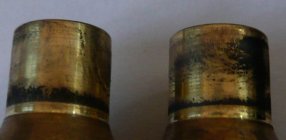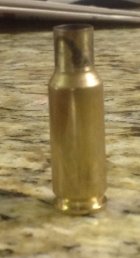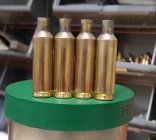You are using an out of date browser. It may not display this or other websites correctly.
You should upgrade or use an alternative browser.
You should upgrade or use an alternative browser.
Thoughts on the Neck Carbon Ring ?
- Thread starter Chubbs
- Start date
rjtfroggy
Gold $$ Contributor
A few weeks ago I posted about a possible bad batch of brass, it was all splitting on the neck on the forth firing. Well if you look at the piece of brass on the left mine all had a very similar mark on the neck and they all split right there. Not saying these will but mine did.
Chubbs sorry to infringe on your post.
Chubbs sorry to infringe on your post.
It's not a 'carbon ring', but sooting.
Optimal would be zero.
For this you need ~1thou neck clearance, ~5thou end clearance or less, lower/normal neck tension, snappy pressure peak. It's a loop that feeds on itself in that the quicker the seal, the less gas/pressure gets around the neck to slow sealing, -for quicker sealing. This helps with ES, and mitigation of actual carbon ring formation in the chamber neck.
For looser conditions, at least determine chamber end and wait on the trimming until it's actually appropriate to do so. This would be when inside of 5thou clearance. Eventually every case in batch would get there, you'd trim as they do, and then they'd all be same and tight.
You can also forget FL sizing of necks. Just remove that from consideration.
Optimal would be zero.
For this you need ~1thou neck clearance, ~5thou end clearance or less, lower/normal neck tension, snappy pressure peak. It's a loop that feeds on itself in that the quicker the seal, the less gas/pressure gets around the neck to slow sealing, -for quicker sealing. This helps with ES, and mitigation of actual carbon ring formation in the chamber neck.
For looser conditions, at least determine chamber end and wait on the trimming until it's actually appropriate to do so. This would be when inside of 5thou clearance. Eventually every case in batch would get there, you'd trim as they do, and then they'd all be same and tight.
You can also forget FL sizing of necks. Just remove that from consideration.
Last edited:
BoydAllen
Gold $$ Contributor
With respect, I disagree about the clearances. I know a couple of short range group record holders, and additionally I would refer you to the series of videos on Youtube by Jack Neary. All say that for best results they want more than .002 clearance, up to .003 and that the larger clearances show up as better accuracy at 200 yards. On the end clearance, I have never seen or heard of anyone improving performance by running it that tight, a lot of theorizing, but no actual test results. In one of his videos Jack, who has been on the USA World Benchrest Championship team, said that for a PPC chamber with a maximum case length of 1.515 he trims to 1.490.It's not a 'carbon ring', but sooting.
Optimal would be zero.
For this you need ~1thou neck clearance, ~5thou end clearance or less, lower/normal neck tension, snappy pressure peak. It's a loop that feeds on itself in that the quicker the seal, the less gas/pressure gets around the neck to slow sealing, -for quicker sealing. This helps with ES, and mitigation of actual carbon ring formation in the chamber neck.
BoydAllen
Gold $$ Contributor
Bushing size has nothing to do with fit in the neck of the chamber. That is determined by neck thickness. Once the bullet is seated, the diameter of the neck is always bullet diameter plus twice the neck thickness. Changing the bushing size just changes the interference fit of the bullet in the ID of the neck, which is expanded to bullet diameter by the bullet when it is seated.
I'll be following this thread intently.
When I size with a Redding body die, bumping my shoulder .002", then Redding neck bushing die, followed by a 21st Century mandrel to set final tension, my neck sooting stops in the area the bushing stop, and looks similar to the OPs pic.
When I try to use my full length Mighty Armor die with expander and decaper, on the same brass, which yields seeming the same brass size dimensions, best I can check with a digital caliper, I get sooting all the way back to the shoulder/body junction. Same load. Same barrel. I've even tried removing the expander and finishing with the above mandrel, but results were the same.
Load isn't light. 42.5gr of H4350 behind Berger 140 Hybrids running 2820fps in 6.5CM.
If this seems like a thread jack, I can start my own.
When I size with a Redding body die, bumping my shoulder .002", then Redding neck bushing die, followed by a 21st Century mandrel to set final tension, my neck sooting stops in the area the bushing stop, and looks similar to the OPs pic.
When I try to use my full length Mighty Armor die with expander and decaper, on the same brass, which yields seeming the same brass size dimensions, best I can check with a digital caliper, I get sooting all the way back to the shoulder/body junction. Same load. Same barrel. I've even tried removing the expander and finishing with the above mandrel, but results were the same.
Load isn't light. 42.5gr of H4350 behind Berger 140 Hybrids running 2820fps in 6.5CM.
If this seems like a thread jack, I can start my own.
BoydAllen
Gold $$ Contributor
I do not know of any competitive shooter that views elimination of neck sooting as a goal. All of their goals relate to what happens at the target. Generally in short range group, many people consider that one sign of a well tuned load is a thin soot line on the neck that takes the shape of a rather coarse sine wave. Here is a picture that Jackie Schmidt posted on the subject.Boyd, I wasn't suggesting ~1thou clearance.
I was explaining that needed for zero neck sooting -as a starting point.
But to relate Jack Nearyisms to the subject at hand, what amount of neck sooting is he suggesting?
Attachments
Dusty Stevens
Shiner
Here is what it should look like. The OP pics do not look right at all.
Carbon pattern on necks
Hi, Could somebody out there explain what causes this and Is it good or bad Im getting a very clean sinewave from the star of the neck to the rim I shall try post pictures. Cheers Trev.
forum.accurateshooter.com
Dusty Stevens
Shiner
Boyd beat me to it, thanks boyd
The soot on my necks stops close to the same point on the neck as OP's picks show (mine is from a .308), though the amount of soot I get if far less that shown there and I never get any soot on the shoulders. I assume mine stoped where it does because I used my Lee collet die to size the necks where there's a space from the collet to the neck shoulder junction. So, I just now tested this with some junk brass I have laying around.
First, I FL sized one with no expander ball as usual and ran my normal expander mandrel through it. Measuring from the mouth to the shoulder junction I got the same measurements. Next, I FL sized that case again and then sized the neck with my Lee collet die and measurements from mouth to shoulder junction were the same (actually at the junction the neck was ~ .0005 larger as best I can tell). So, now I'm not convinced that the collet die is responsible for where the soot line is stopping.
And BTW, my fired brass with that soot line are all neck turned and have the same measurement from the mouth to shoulder junction (+/- .0005 on that shoulder length).
It could be from a donut forming just above the shoulder junction after 5 firings as when I measured some of my loaded rounds I found a difference of ~.001.
So, I'm still not sure just why the soot stops where it does.
First, I FL sized one with no expander ball as usual and ran my normal expander mandrel through it. Measuring from the mouth to the shoulder junction I got the same measurements. Next, I FL sized that case again and then sized the neck with my Lee collet die and measurements from mouth to shoulder junction were the same (actually at the junction the neck was ~ .0005 larger as best I can tell). So, now I'm not convinced that the collet die is responsible for where the soot line is stopping.
And BTW, my fired brass with that soot line are all neck turned and have the same measurement from the mouth to shoulder junction (+/- .0005 on that shoulder length).
It could be from a donut forming just above the shoulder junction after 5 firings as when I measured some of my loaded rounds I found a difference of ~.001.
So, I'm still not sure just why the soot stops where it does.
Well I thought if you use too small a bushing and sized the neck down too much, regardless of the neck thickness, it would be sloppy in the chamber and all powder/soot to flow back around the neck area, causing the soot.Bushing size has nothing to do with fit in the neck of the chamber. That is determined by neck thickness. Once the bullet is seated, the diameter of the neck is always bullet diameter plus twice the neck thickness. Changing the bushing size just changes the interference fit of the bullet in the ID of the neck, which is expanded to bullet diameter by the bullet when it is seated.
Seems like I have been using neck bushings all wrong and it matters not what size they are then, as long as they are close and you neck turn the thickness down. Smile.
You still have to put a bullet back into it, so the bullet diameter plus 2*wall thickness is what goes into the chamber.Well I thought if you use too small a bushing and sized the neck down too much, regardless of the neck thickness, it would be sloppy in the chamber and all powder/soot to flow back around the neck area, causing the soot.
Seems like I have been using neck bushings all wrong and it matters not what size they are then, as long as they are close and you neck turn the thickness down. Smile.
Chubbs
My guess is the sharp carbon line on your necks is caused by a bushing that is not sizing down all the way to the neck shoulder junction. And if you did not use a non-bushing full length on your cases before neck turning you have pre-formed donuts below your carbon line.
In WWII terms you are fighting the battle of the bulge.


And your wife would say you have ring around the collar.
My guess is the sharp carbon line on your necks is caused by a bushing that is not sizing down all the way to the neck shoulder junction. And if you did not use a non-bushing full length on your cases before neck turning you have pre-formed donuts below your carbon line.
In WWII terms you are fighting the battle of the bulge.

And your wife would say you have ring around the collar.
Last edited:
BoydAllen
Gold $$ Contributor
Bushing size is a tuning factor. It does matter, just not for loaded neck diameter. It changes bullet seating force, and pull.Well I thought if you use too small a bushing and sized the neck down too much, regardless of the neck thickness, it would be sloppy in the chamber and all powder/soot to flow back around the neck area, causing the soot.
Seems like I have been using neck bushings all wrong and it matters not what size they are then, as long as they are close and you neck turn the thickness down. Smile.
Upgrades & Donations
This Forum's expenses are primarily paid by member contributions. You can upgrade your Forum membership in seconds. Gold and Silver members get unlimited FREE classifieds for one year. Gold members can upload custom avatars.

Click Upgrade Membership Button ABOVE to get Gold or Silver Status.
You can also donate any amount, large or small, with the button below. Include your Forum Name in the PayPal Notes field.
To DONATE by CHECK, or make a recurring donation, CLICK HERE to learn how.

Click Upgrade Membership Button ABOVE to get Gold or Silver Status.
You can also donate any amount, large or small, with the button below. Include your Forum Name in the PayPal Notes field.
To DONATE by CHECK, or make a recurring donation, CLICK HERE to learn how.












